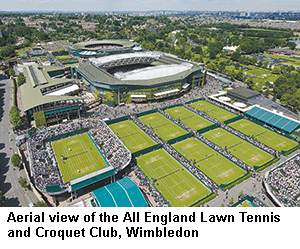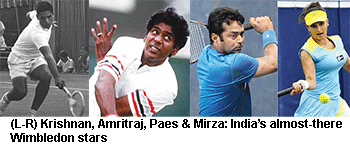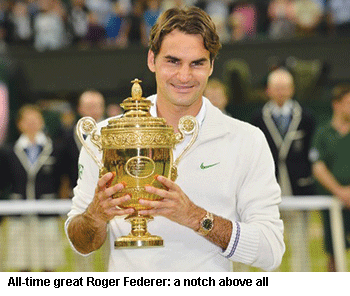Of the four Grand Slam tennis tournaments held around the world, Wimbledon is the most prestigious. The other three, the Australian, French and US Open, pale in comparison. Wimbledon isn’t only the oldest of them all, it combines tradition and glamour - Rahul Singh
 This summer was green and pleasant because despite the odds being against it, I was able to fulfill my annual ritual of attending the Wimbledon Lawn Tennis Championship. I usually make it a point to spend at least a few days there every year, preferably sitting on a hallowed centre court seat. Of the four Grand Slam tennis tournaments held around the world, Wimbledon is the most prestigious. The other three, the Australian, French and US Open, pale in comparison. Wimbledon isn’t only the oldest of them all, it combines tradition and glamour, making it perhaps the most watched individual sporting event worldwide, barring the Olympics.
This summer was green and pleasant because despite the odds being against it, I was able to fulfill my annual ritual of attending the Wimbledon Lawn Tennis Championship. I usually make it a point to spend at least a few days there every year, preferably sitting on a hallowed centre court seat. Of the four Grand Slam tennis tournaments held around the world, Wimbledon is the most prestigious. The other three, the Australian, French and US Open, pale in comparison. Wimbledon isn’t only the oldest of them all, it combines tradition and glamour, making it perhaps the most watched individual sporting event worldwide, barring the Olympics.
Actually, the fortnight-long epic tournament is staged at the All England Lawn Tennis and Croquet Club. Wimbledon is merely its location, in south London. Spread over 42 acres, with a total of 31 courts, 18 of them grass, it is the only Grand Slam played on grass, the others being on red clay (Roland Garros, Paris) or rubberised hard courts. However Czech-born Ivan Lendl, one of the greatest players never to win Wimbledon (along with Australian Ken Rosewall), grumpily dismissed it as a surface fit only for cows.
Be that as it may, Wimbledon still attracts all the world’s top players. The impressive prize money — equivalent of Rs.19 crore each for the men’s and women’s singles winners with even a first round loser getting Rs.30 lakh — is undoubtedly a strong incentive. But it’s not just the prize money that makes Wimbledon so special. It has an almost mystical quality that combines Royalty (an obligatory courtesy by competitors entering the court towards the Royal Box graced by the Queen or a close relative) with typical British quirkiness — the insistence on all players wearing pristine white, for instance. This year the organisers made women’s finalist Venus Williams change her pink bra, much to her amusement. Or the serving of strawberries and cream during the tournament, the fruit plucked fresh at 4 a.m every day with 140,000 servings sold during the fortnight, together with 35,000 bottles of champagne.
I have been to Wimbledon several times, braving serpentine queues and frequent downpours. The first two occasions were when our own national champ Ramanathan Krishnan reached the semi-finals. Admittedly, this was before the ‘Open’ era, and only amateurs were allowed to play at Wimbledon. Tennis professionals, who understandably wanted to earn some money from their talent were barred. Nevertheless, no Indian had ever reached the semi-finals before, so it was a proud moment for us. In those days, the cheapest way to watch a centre court match was to buy a ‘standing room’ only ticket (later done away with, for security reasons). There I was straining my neck, cheering my hero. But it was not to be. Krishnan lost in 1960 to Neale Fraser and in 1961 to Rod Laver, in straight sets. Both of them went on to win the title. Krishnan had a delightful ‘touch’ game, based on uncanny anticipation, deft volleys and drop shots. No big serve and volley for him. But his touch deserted him on both occasions.
Vijay Amritraj, on the other hand, had an all-round game. He was tall and nimble with a powerful serve and killer  volleys. Critics wrote about the ‘A, B, and C’ of rising tennis stars in those days, referring to Amritraj, Borg and Connors. However, Swede Bjorn Borg and American Jimmie Connors went on to become immortals of the game, winning numerous Grand Slams. Amritraj didn’t figure in a single Grand Slam final. On one occasion at Wimbledon that I recall vividly, he was leading two sets to love against Connors, and the commentator, the legendary Fred Perry, said there was no way Amritraj could lose. Yet Connors, street-fighter that he was, came storming back to defeat the Indian. Unfortunately, Amritraj lacked the killer instinct.
volleys. Critics wrote about the ‘A, B, and C’ of rising tennis stars in those days, referring to Amritraj, Borg and Connors. However, Swede Bjorn Borg and American Jimmie Connors went on to become immortals of the game, winning numerous Grand Slams. Amritraj didn’t figure in a single Grand Slam final. On one occasion at Wimbledon that I recall vividly, he was leading two sets to love against Connors, and the commentator, the legendary Fred Perry, said there was no way Amritraj could lose. Yet Connors, street-fighter that he was, came storming back to defeat the Indian. Unfortunately, Amritraj lacked the killer instinct.
Actually, both Krishnan and Leander Paes won the Wimbledon junior titles, effectively being crowned the best junior players of the world. Krishnan beat Australian Ashley Cooper in his final. But while Cooper went on to win the Wimbledon men’s title two years later, Krishnan never got beyond the semi-finals. As for Paes, he went nowhere in the singles of all Grand Slams (except for some notable wins in the Davis Cup). But he became an exceptional doubles player. He and Mahesh Bhupathi formed one of the best doubles combinations in the world, even lifting the Wimbledon doubles championship. But they fell out for personal reasons (over a young lady, rumour had it). They took other partners in both men’s and mixed doubles and won several Grand Slams separately.
Paes is the highest Indian earner of prize money, having won the equivalent of some Rs.53 crore. Sania Mirza, also a doubles specialist with several Grand Slams to her name, comes close with Rs.42 crore of prize money. That’s a staggering amount by Indian standards but pales in comparison with what Swiss Roger Federer has earned, roughly Rs.650 crore. Multiply that by at least ten, for what he has got from various endorsements and you get an incredible figure of around Rs.6,500 crore, making him perhaps the most rewarded person in an individual sport ever. And he is still winning tournaments and endorsements. The only sportsperson who could have matched him is American golfer Tiger Woods but he underwent an abrupt and sudden decline because of ‘sex addiction’ in recent years. Federer strides on at 36, an age widely considered too old for top-level competitive tennis.
Yes, Paes, Bhupathi and Mirza have kept the Indian tennis flag flying. But who really cares about doubles? Very few. Borg and Federer haven’t even bothered to play doubles at any of the Grand Slams, only in Davis Cup ties, where the format requires one doubles match.
 So, who are the best Wimbledon champions of our era? Australian great Rod Laver bridged the gap between the amateur and Open era. He won as an amateur in 1962 and again in 1968 when Wimbledon was thrown open to all, including professionals. His game was built on wonderful ground strokes, a fluid serve and piercing, angled volleys. Swede Bjorn Borg, nicknamed ‘Ice Borg’ for his impassivity on court — until the moment of triumph when he would sink to his knees — brought a new dimension to the game. With his flowing locks, his patented double-fisted backhand, and his incredible court speed, he excelled on all surfaces. He won five successive Wimbledon singles titles, plus three successive French titles in the same year, a feat nobody had accomplished before or since. Borg had prodigious talent. He was the first tennis rock star, invariably followed by a screaming mob of female fans.
So, who are the best Wimbledon champions of our era? Australian great Rod Laver bridged the gap between the amateur and Open era. He won as an amateur in 1962 and again in 1968 when Wimbledon was thrown open to all, including professionals. His game was built on wonderful ground strokes, a fluid serve and piercing, angled volleys. Swede Bjorn Borg, nicknamed ‘Ice Borg’ for his impassivity on court — until the moment of triumph when he would sink to his knees — brought a new dimension to the game. With his flowing locks, his patented double-fisted backhand, and his incredible court speed, he excelled on all surfaces. He won five successive Wimbledon singles titles, plus three successive French titles in the same year, a feat nobody had accomplished before or since. Borg had prodigious talent. He was the first tennis rock star, invariably followed by a screaming mob of female fans.
The two McEnroe versus Borg Wimbledon finals were all-time classics, two entirely different styles of play and personalities pitted against each other, Borg winning the first one and McEnroe the second. After that loss, Borg decided to retire from the sport, perhaps sensing that McEnroe would get the better of him from that time onwards. Borg was only 25, an age when many sportsmen are in their prime.
Pete Sampras, aka Pistol Pete, was probably the greatest exponent of the serve-and-volley style of play, the point being over after the exchange of only three or four strokes. Wimbledon’s natural grass heavily favoured big servers, as the ball kept low after shooting speedily from the surface. He won the Wimbledon title seven times, a record beaten only by Federer.
Then, in 2000-2001, Wimbledon officials made a radical change. They relaid the grass with perennial rye-grass, which is hardier, dries better and enables higher ball bounce. This meant the end of serve-and-volley era. Longer baseline rallies started to become the norm at Wimbledon. Meanwhile, technology was also changing with the wood frame racket giving way to lighter and more powerful graphite and fiberglass rackets. The strings of the racket, too, earlier made from sheep intestines, were replaced with polyester, less susceptible to the vagaries of weather.
Simultaneously, a new genre of tennis players, mostly over 6 ft tall and powerfully built has emerged. Rafael Nadal and Novak Djokovic, tower over Rod Laver and Ken Rosewall, greats of another era, neither of them particularly tall or muscular. The era of the baseline players, dominant at the other Grand Slams, had begun at Wimbledon as well. Long baseline rallies became the norm, the serve-and-volley game the exception. Four men dominated: Djokovic, Nadal, Murray and of course Federer. Few periods in tennis history have had such outstanding players as these four.
Why is Roger Federer a notch above them all, and acknowledged by many as the greatest tennis player of all time? The way he plays has something to do with it, as well as his record as winner of the greatest number of Grand Slams. His game is not based on brute force or power. It has a sublime ballet-like grace and athleticism. Some of his shots remain etched in memory. But he has something else, which others don’t, making him stand out: charisma. That makes him among the greatest sportsmen of an individual sport of our time, along with Muhammad Ali, Usain Bolt and Tiger Woods.
This feature began with Wimbledon. Need I say that t his year’s Wimbledon was entirely dominated by him? Nearing 36, he won the title without losing a set. The man he beat in the final, Marin Cilic, shed tears after his loss, probably out of sheer frustration. Federer did too, but that’s his nature and his fans adore him for it. It shows his humanity, his vulnerability.
his year’s Wimbledon was entirely dominated by him? Nearing 36, he won the title without losing a set. The man he beat in the final, Marin Cilic, shed tears after his loss, probably out of sheer frustration. Federer did too, but that’s his nature and his fans adore him for it. It shows his humanity, his vulnerability.
Apologies, that no mention has been made of the great women players of Wimbledon in our era: Steffi Graf, Chris Evert, Martina Navratilova, and, of course, the greatest of them all, Serena Williams (absent this year due to her first pregnancy). That will need another feature. Meanwhile, let us revel in Roger Federer, a sight to behold for the gods.